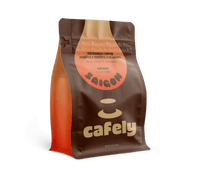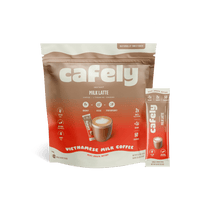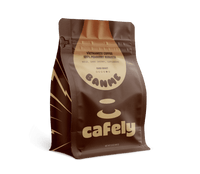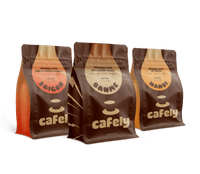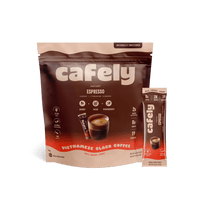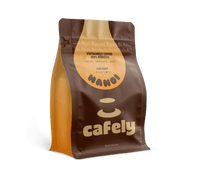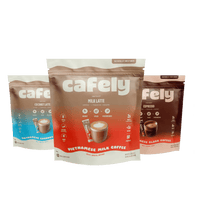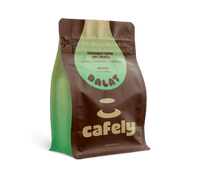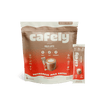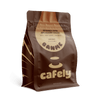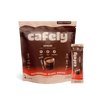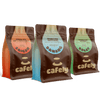Are you tired of sipping coffee that barely has any flavor?
You may be using the wrong roast to make your morning cup of Joe.
Dark roast coffee provides a deep smoky aroma, dark chocolatey notes, and a smooth finish that pleases the senses.
In this article, we look at the best dark roast coffee on the market and discuss what makes this roast level unique. We also touch on some interesting science about the roasting process.
What is the Best Dark Roast Coffee?
The best dark roast coffee should be organic, mold-free, and freshly roasted. Dark roasts are available in either arabica, robusta, or blends of both beans.
Here’s what to look for in the best dark roast coffee:
- Whole-Bean — Always opt for whole-bean dark roast coffee and grind it fresh just before brewing. Coffee goes stale quickly after grinding — grinding the beans yourself ensures you produce the most charismatic cup with the widest flavor profile.
- Arabica — 100% arabica coffee such as Cafely DaLat (Dark Roast) offers a smooth, sweet, delicate flavor profile. Coffee arabica bean is the best choice if you want to make espresso and espresso-based brews.
- Robusta — 100% robusta coffee is much bolder than arabica. Dark roast robusta such as HaNoi and BanMe Coffee offer notes of nuts, chocolate, and black cherry. Robusta is around twice as strong as arabica, making it perfect for iced coffee, bold milky brews, and Vietnamese coffee.
- Blends — Blends combine the qualities of both arabica and robusta. If you want a versatile coffee that works well for espresso machines, French press, sturdy pour-over, and iced brews, opt for a dark roast blend such as Saigon OG.
What Is Dark Roast Coffee?

Dark roast coffee is roasted to around 440˚F (226˚C) or above. At this temperature, the coffee beans reach what’s known as the second crack stage.
The “crack” system is perhaps the most well-known metric for coffee roasting. When white beans are roasted, the water within them evaporates and escapes. This process expands each bean, leading to a cracking noise. This process happens twice — once at 405˚F (first crack), and once at 440˚F (second crack).
Coffee can be roasted for a while after that second crack. An example of a coffee taken past the second crack stage is a French roast, which is extremely dark. After the French roast level, the beans start to burn.
Dark roast coffee typically comprises beans that are so dark, they’re virtually black. The beans also release oils during roasting, giving them a shiny, slightly waxy appearance.
The flavor notes of dark roast coffee are mainly developed during the roasting process rather than from the beans themselves. A common trait is sweetness from sugars released by the bean and caramelized in the heat. The beans will also have a rich earthiness and darkness, compared to a light roast that may have fruitier notes.
How Is the Roast Level Measured?
Calling something “darker” or “lighter” is a relative term, so judging the roast level of coffee is a bit complex. Fortunately, there are two systems for judging the darkness of a roast — the Agtron scale and the City scale.
The Agtron scale measures the color of any given item. The 100-point scale evaluates the exact color of a coffee bean. You add a sample to a machine, and the machine spits out an Agtron number. The higher this number is, the lighter the color of the sample is.
The Agtron scale is only really used by large coffee companies because the machine needed to measure the score is very expensive. As such, most smaller roasters don’t use this system but may use the City scale.
The City scale defines a roast using a combination of color, weight loss, and “crack.” It starts at the first crack of the coffee bean and measures eight increments of roast — 1st Crack, City -, City, City+, Full City, Full City+, French, and Burnt.
Comparing Light and Dark Roast Coffee
Since there’s such a large spectrum of different flavors available across the world of top-quality coffee, it can be tough to define the main flavors of different roast levels.
Here are some key differences between light and dark roasts to bear in mind:
|
Property |
Light Roasted Coffee |
Dark Roasted Coffee |
|
Appearance |
Typically, it’s a light brown color and dry on the surface. |
Darker in color, from medium to dark brown. Some oil is present on the surface of the beans. |
|
Flavor |
The beans' original flavors are somewhat preserved, leading to floral and fruity notes. Light roast beans are often described as more complex than dark roasts. |
Much richer and darker in flavor, with some roasted, caramelized, and even smoky flavors present in the final brew. Generally lower in acidity, so diminished fruity or floral notes. |
|
Aroma |
It tends to have a pronounced aroma with specific fragrances. Light roasts from different countries can have unique aromas. |
Stronger and more earthy aroma, with richness and bitterness coming through. |
|
Caffeine |
Slightly more caffeine content than dark roasts. |
Slightly less (but negligible) caffeine content than light roasts — the longer roasting period can cause some caffeine to degrade. |
|
Body |
A typically cleaner body, with less density and mouthfeel. The slightly higher acid content can give the coffee a crisp and sharp body. |
The richness and earthiness of the flavors give the final cup a slightly thicker texture with a heavy body. The oils on the beans can give the final cup a slight smoothness and buttery mouthfeel. |
|
Acidity |
Light roasts have higher acidity — this often comes across as fruity or floral, as well as a general sharpness and brightness. |
A lower acidity level due to the evaporation of liquids from the beans during roasting leads to a smoother, more mellow flavor overall. |
Health Benefits of Dark Roast Coffee

Dark roast coffee may have some surprising health benefits. Most notably, researchers have found that people who drink a moderate amount of coffee daily may have a lower chance of getting Alzheimer’s disease. They’ve also found coffee drinkers experience reduced inflammation and may have a reduced risk of developing type 2 diabetes [1].
Both light and dark roast coffee contain chlorogenic acid and polyphenols (which have antioxidant properties). These antioxidants reduce oxidative stress in the body and may help with weight loss [2].
While research suggests dark roast coffee may have fewer nutrients overall due to the heat cooking phytochemicals out during roasting, dark roast coffees also have lower acrylamide levels [3]. Acrylamide is linked to an increased risk of cancer. Dark roast coffee could be potentially safer than light roast coffee due to its lower acrylamide levels.
How to Prepare Perfect Dark Roast Coffee

You can extract the flavor from dark roast coffee more efficiently than light roast coffee. A shorter brew time and lower brewing temperature are ideal for a dark roast. You can extract the flavors in a coffee without over-extracting at temperatures between 195˚F (90˚C) to 208˚F (98˚C).
Here are three of the best ways to prepare and brew dark roast coffee:
1. Espresso Machine
One of the most common brewing methods for dark roast coffee is espresso brewing process. This method is commonly used to brew dark roast arabica coffee or arabica-rich blends.
During brewing, the grounds and the water only come into contact for around 20 to 30 seconds at around 9 bars of pressure. This allows for a fast, concentrated extraction which produces a strong, deep, bold cup without extracting the bitter, burnt flavors from the beans.
2. Moka Pot
Another brewing method that relies on high pressure and a short contact time is the moka pot.
The idea is very similar to an espresso machine — the heat forces the water through a compressed bed of finely ground coffee. However, in a moka pot, the water is typically hotter than in an espresso machine. This leads to a stronger extraction — producing an espresso-like cup with a more robust flavor.
3. Phin Filter
The phin filter is a traditional Vietnamese brewer that uses gravity to brew coffee. The pressure from the gravity press and the fine filter plate help create a bold, dark cup of coffee.
Phin filters are perfect for brewing dark roast robusta coffee. Brews made with the phin filter are traditionally combined with sweetened condensed milk. This sweet dairy product mellows out the intense, dark, bitter flavors of robusta.
Choosing the Best Dark Roast Coffee
Finding the perfect dark roast coffee for your cup can be a challenge, especially if you’re new to specialty coffee.
To find that perfect bittersweet flavor, here are some factors that it may help to bear in mind:
1. Organically Grown
Buying organic ensures your beans are good for the environment and contain as few harmful chemicals as possible. To keep any contaminants out of your cup, organic farmers are your friends.
2. Certified Mold-Free
Coffee can experience mold growth during transit, which may leave behind mycotoxins. Though these chemicals are rare, you can guarantee to avoid them by tracking a lab-tested mold-free dark roast.
3. Sugar-Free
Some dark roast coffees can be poorly roasted. Rather than wasting the beans, a company might add sugar to cover up bad flavors. To make sure you’re getting top-notch dark roast coffee, look for coffee with no added sugar or with natural sweeteners like organic monk fruit that are designed to work with the flavors rather than hide them.
4. Freshly Roasted
Roasting coffee imparts almost all of the flavor that you find in your final cup. In storage, a lot of the unique and delicious character that your beans have is lost. Avoid that flavor loss by always buying dark roast beans with a recent roast date.
5. Freshly Ground
Grinding coffee beans can also lead to some flavor loss with time. The increased surface area interacts with more oxygen, which makes the beans stale faster. For the most intense flavors, always make sure that you grind your coffee as close to brewing as possible.
6. Country of Origin
The soil the plant is grown in will impart flavors to the beans, so each country’s coffee will have different attributes. On top of that, traditional roasting techniques from that area bring unique flavors into your home. To try some delicious traditional roasting techniques, we’d suggest opting for Vietnamese coffee.
Our Top Dark Roast Coffee Picks
These dark roast coffee selections are big on roast flavors and gently coaxed sweetness:
HaNoi (100% Robusta)
 The impressive HaNoi blend is a tribute to the coffee culture of the city it’s named after. In Vietnam, robusta coffee has long been roasted dark, and our skilled roasting team expertise recreates this classic flavor.
The impressive HaNoi blend is a tribute to the coffee culture of the city it’s named after. In Vietnam, robusta coffee has long been roasted dark, and our skilled roasting team expertise recreates this classic flavor.
DaLat (100% Arabica)
 This arabica coffee comes from the DaLat region of Vietnam and is roasted to a dark level to pull out the signature fruity flavor and smooth texture of coffee grown in the area. These beans create a surprisingly sweet coffee with decadent flavors like stone fruit and caramel.
This arabica coffee comes from the DaLat region of Vietnam and is roasted to a dark level to pull out the signature fruity flavor and smooth texture of coffee grown in the area. These beans create a surprisingly sweet coffee with decadent flavors like stone fruit and caramel.
BanMe (100% Peaberry Robusta)
 Our BanMe Coffee has a rich and luxurious flavor, as well as a high caffeine content compared to similar coffees on the market. Despite the exceptionally dark roast, the final brew is pleasantly smooth, with a thick, rolling mouthfeel.
Our BanMe Coffee has a rich and luxurious flavor, as well as a high caffeine content compared to similar coffees on the market. Despite the exceptionally dark roast, the final brew is pleasantly smooth, with a thick, rolling mouthfeel.
FAQs: Dark Roast Coffee
Do you want to learn more about dark roast coffee?
Check out the answers to the frequently asked questions below and head over to the Cafely Blog to learn more about coffee, brewing, and other caffeinated beverages…
1. What Are Some Common Tasting Notes in Dark Roast Coffee?
Typically, dark roast coffee has a smooth, rich flavor. The extended roasting time caramelizes the sugars within the beans, leading to a slightly sweeter flavor. This roasting time can also lead to more intense, earthy, and smoky notes.
2. How Do You Define a Dark Roast Coffee?
Many scales — including the Agtron scale and the City scale — can measure the relative darkness of a coffee’s roast level. The most convenient and accessible method is the “crack” system, where roasters listen for the sound of the beans during roasting. A dark roast is cooked slightly longer than the second crack noise.
3. What’s the Best Grind Level for Dark Roast Coffee?
Generally, you can extract the coffee flavors out of dark roast coffee more easily than light roast coffee. With that in mind, you may want to grind dark roast coffee more coarsely to avoid over-extraction when using immersion brewing (French press, pour-over, drip coffee).
4. What’s the Best Water Temperature for Dark Roast Coffee?
Use a lower temperature to prevent over-extraction if you’re using a brewing method, like French Press, that takes a longer period of time.
5. What Are the Health Benefits of Dark Roast Coffee?
While there is a lot of research about the health benefits of coffee in general, the only difference between dark and light roasts is that dark roasts tend to have less of a chemical called acrylamide. Some studies have linked acrylamide to a slightly higher risk of cancer, so having less of it in your coffee is certainly a health benefit.
6. How Can You Tell the Difference Between Light and Dark Roast Coffee?
You can typically tell the difference between light roast and dark roast coffee in two ways — aroma and appearance.
Typically, a light roast will have a more floral or fruity aroma, while a dark roast will have a more intense and roasted smell. A darker roast may appear to be shinier than a light roast because some oils from the beans are released onto the surface at high temperatures.
References:
- Shahinfar, H., Jayedi, A., Khan, T. A., & Shab-Bidar, S. (2021). Coffee consumption and cardiovascular diseases and mortality in patients with type 2 diabetes: A systematic review and dose-response meta-analysis of cohort studies. Nutrition, metabolism, and cardiovascular diseases: NMCD, 31(9), 2526–2538.
- Watanabe, T., Kobayashi, S., Yamaguchi, T., Hibi, M., Fukuhara, I., & Osaki, N. (2019). Coffee Abundant in Chlorogenic Acids Reduces Abdominal Fat in Overweight Adults: A Randomized, Double-Blind, Controlled Trial. Nutrients, 11(7), 1617.
- Várady, M., Ślusarczyk, S., Boržíkova, J., Hanková, K., Vieriková, M., Marcinčák, S., & Popelka, P. (2021). Heavy-Metal Contents and the Impact of Roasting on Polyphenols, Caffeine, and Acrylamide in Specialty Coffee Beans. Foods (Basel, Switzerland), 10(6), 1310.
